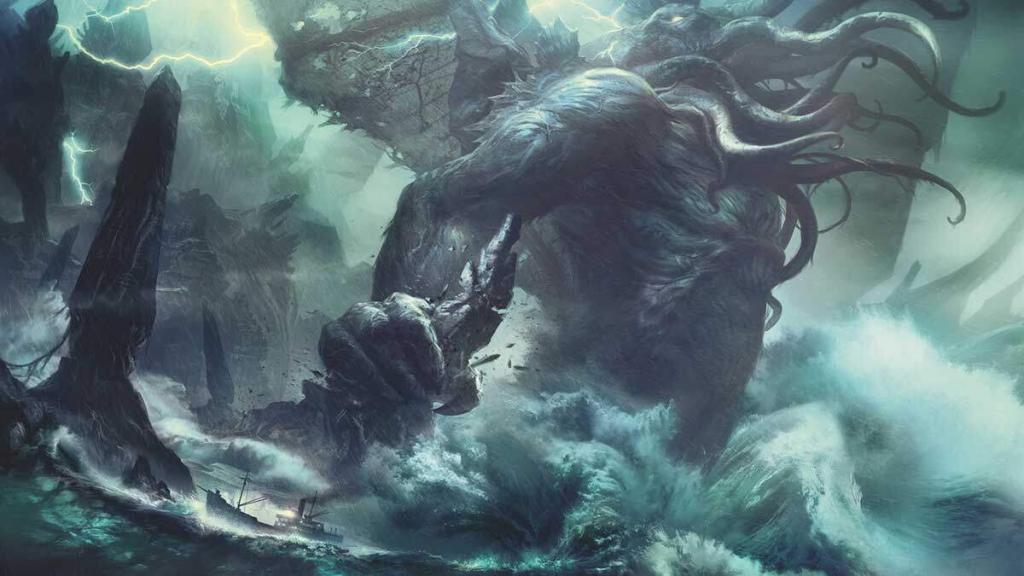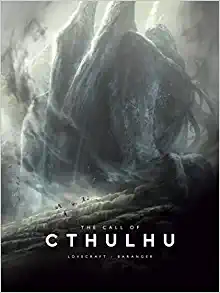The time is once again upon us to take a plunge into the morbid and cosmic horror world of H. P. Lovecraft, once more staggeringly illustrated by the visionary François Baranger. I’m now two books into this series which is beginning to feel akin to a sort of cinematic universe, only retained on paper where it can truly pay tribute to Lovecraft’s original work. Whereas the first part of At The Mountains of Madness left me hanging on the edge of a sheer plummet into darkness, Call of Cthulhu, a much shorter tale, manages to contain it’s entire self within the confines of this gargantuan hardback. But only just.
With this being a story I’m familiar with and one I managed to enjoy in a single sitting along with all of the gorgeous artwork it swims in, how did Baranger and Free League Publishing do? In short: terrifyingly well.
Call of Cthulhu is a rather more nautical outing than it’s snowy predecessor in this series and, for those with sensibilities such as my own, holds far more capacity for cosmic horror and its suffocating vastness. This story deals primarily with scale: the ocean, the dreaded city of R’lyeh, and the tentacled megalith himself; almighty Cthulhu. Of course the narrative wades in accounts and letters and newspaper articles in classic Lovecraft fashion, but towards the final act things heat up to boiling point and we’re treated to several devastating views of the alien geometry of R’lyeh and the towering, tentacled form of the lumbering god himself.
I’ve mentioned in the past that Baranger’s art makes Lovecraft’s writing even more dramatic and far more accessible. You’d be hard-pressed to find someone who hasn’t heard of Cthulhu these days, or at least seen one of the countless artistic depictions of the squid-dragon goliath. He was an obvious choice for this next huge illustrated issue, and the payoff involves some truly chilling images.
In an age of plush toys and parodies it’s good to see my personal favorite oceanic behemoth in a style more befitting his true nature, and in a book big enough to support him. These hand-painted renditions depict the colossal elder god rising from unfathomable depths, looming over a fiery, decimated New York and roaring into the heavens beneath stomach-dropping storms. It truly is the best tribute to the visual horror of Cthulhu that i’ve witnessed, and serves as the perfect accompaniment to Lovecraft’s unsettling tale.

Thematically, the narrative centers around madness and obsession, as is common in Lovecraft’s work, though perhaps not to the extent of detail and thoughtfulness as displayed in this masterpiece of a short story. Implications of extensive lore are found throughout logs, notes, newspaper articles, alien statues and accounts of outlandish dreams. Much of it is a story within a story as our narrator, Francis Weyland Thurston pores over his late uncle’s notes and a strange bas-relief depicting Cthulhu reigning over R’lyeh. Insanity is displayed through obsessive artistry, mass hysteria and primordial cultism. The pervading racism is unfortunately as apparent as we’ve come to expect from this particular author. While the ignorance much of Lovecraft’s work is rooted in should not be glossed over, the style of story helps separate art from artist and merely take this as the views and wording of Thurston and his uncle.
Baranger’s art remains moody yet grounded and rooted in realism so that when our titular overlord finally awakens, first time readers can breathe a sigh of relief that such an intense story ends on more than just implication. Lovecraft himself would be delighted and terrified at these powerful renditions of his brain spawn. I for one can’t wait to see what comes next in the series; with such an extensive backlog to choose from we’re left with infinite potential for stomach-dropping cosmic horror imagery.
Joe first knew he wanted to write in year six after plaguing his teacher’s dreams with a harrowing story of World War prisoners and an insidious ‘book of the dead’. Clearly infatuated with horror, and wearing his influences on his sleeve, he dabbled in some smaller pieces before starting work on his condensed sci-fi epic, System Reset in 2013.Once this was published he began work on many smaller horror stories and poems in bid to harness and connect with his own fears and passions and build on his craft.
Joe is obsessed with atmosphere and aesthetic, big concepts and even bigger senses of scale, feeding on cosmic horror of the deep sea and vastness of space and the emotions these can invoke. His main fixes within the dark arts include horror films, extreme metal music and the bleakest of poetry and science fiction literature.
He holds a deep respect for plot, creative flow and the context of art, and hopes to forge deeper connections between them around filmmakers dabbling in the dark and macabre.


